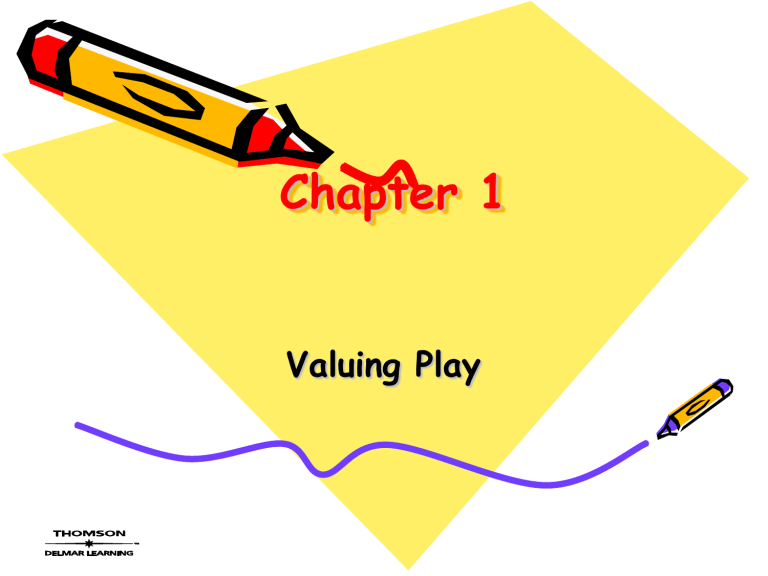ch. 1 play 07

Chapter 1
Valuing Play
• Chapter one activity
• Think about your favorite play activity as a child and write about it.
– Share your experience with a partner or group of 3 next to you. (a few minutes)
• Did play occur outdoors or indoors?
• What was your age?
• How does play and remembering play make you feel?
• How was play valuable to you?
• What messages were send to you about play from the adults in your life? Did they play with you?
Is play valuable?
If so, for whom?
Observable
Behaviors
(What adults see)
Defining Play
Components of play
Characteristics of Play
(What children experience)
Contexts of Play
(What impacts it and where it occurs)
Characteristics of Play
Voluntary
Requires active involvement
Free of external rules
Play
Pleasurable Symbolic
Focuses on action rather than outcomes
What is your definition of play?
Think—Pair—Share
Educational Definition
Focuses on
Characteristics
• Play is pleasurable.
• Play is voluntary and intrinsically motivated.
• Play is symbolic, meaningful, and transformational.
• Play actively engages the players.
• Play is rule-bound.
• Play focuses on process rather than product.
Advocacy Definition
• Play is natural and valuable for all young children.
• Play and development are reciprocal, progressive, and transformative.
• Play promotes good physical and mental health.
• All children should have easy access to play places that are safe and that support quality play.
• All children have the right to play as stated in
Article 31 of the United Nations Convention on the Rights of the Child .
Comparing Play and
Exploration
Play
• positive affect
• creative combinations, improvisational
• casual demeanor; heart rate is variable
Exploration
• neutral affect
(cautious)
• stereotypical behaviors
• Intense; heart rate is steady; and concentration evident
Comparing Play and
Playfulness
• Play
– observable behaviors
– reproducible context
– characteristics of play
• Playfulness
– personality trait or internal disposition
• spontaneity
• openness
• curious
• joyful
• humorous
• communicative
• emotionally expressive
Levels of Cognitive Play
• Sensorimotor play
• Symbolic play
• Games with rules
Levels of Sensorimotor
Play
• Practice play or functional play
– mere practice play-repeating an act for pleasure already been mastered (riding bike, tying & untying shoes)
– fortuitous combinations-practice play discovers new way of putting activities together (blocks)
– intentional combinations-new behaviors are deliberately combined, symbolic (blocks turn into a wall)
– constructive play- use materials to create or construct something (blocks, paint, play-doh)
Levels of Symbolic Play
• Level I (Birth to 2 years)
– symbolism begins
• Level II (2 to 7 years)
– Orderliness-spoon on a placemat
– exact imitation of reality – imitates reality
– collective symbolism with differentiation and complementary adjustment of roles- children agree to different roles
Levels of Social Play
• unoccupied behavior
• onlooker behavior
• solitary play
• parallel play
• associative play
• cooperative play
Contexts of Play
child microsystem exosystem macrosystem
• Mesosystem
– interaction between two systems
– chronosystem— impact of factors over time
To support play, adults should…
• maintain healthy, safe, play spaces.
• develop schedules that ensure that basic physiological needs are met.
• cultivate an array of familiar peers, materials, or other culturally relevant materials.
• display behaviors that encourage but do not disrupt play.
• establish an agreement between the adult and the child that play can occur. Signals are often used to indicate that this is a psychologically safe play space.
Specific actions that encourage play include…
• focusing on the process (rather than the goal) of play. Ask exploratory questions that help extend the child’s play.
• elaborating and building on children’s play or interests. Make comments, offer new and varied materials.
• reflecting the emotions children express in their play and actions. This labels and validates children’s feelings.
Encouraging play (cont.)
• defining the problem. Help children learn negotiation skills. Encourage them to think about alternatives.
• providing varied materials to encourage exploration and play.
• providing open-ended materials for play.
(Klein, Wirth, and Linas, 2003, pp. 40–
41)
Obstacles to Play
• poverty and violence
• changing cultural values
• inadequate space
• overemphasis on academics
Summary
• Play can be defined and studied using specific criteria.
• Characteristics, observable behaviors, and context guide the study of play.
• Play can and should be an important part of every child’s life.
• Wrap up
– In groups of two or three come up with a pneumonic for the six educational characteristics of play.
– Share





